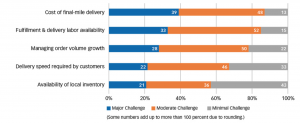More and more young people are moving into cities. To reach this increasingly important market segment, retailers need to find a profitable and efficient way to do urban fulfillment. The CSCMP Supply Chain Quarterly presents an overview of trends and state of art in urban fulfillment.
Challenging urban settings
Fulfilling small volume, high frequency, rapid-velocity omnichannel orders in highly congested urban settings, however, adds complications to omnichannel order fulfillment. Rising real estate costs make it impractical to establish high-capacity urban fulfillment centers that can provide efficient access to a wide assortment. Vehicle parking challenges and proposed restrictions on delivery times in urban areas can limit the ability to support consistent, same-day delivery. Serving customers in high-rise offices and limited-access residential buildings adds to delivery complexity, time, and cost.
In the “Eighth Annual State of Retail Supply Chain (SRSC) Report,” nearly 60 percent of the participants said they are active in urban fulfillment. Furthermore, that interest is increasing, with 80 percent of all respondents indicating that urban fulfillment is a growth area for their company. Additionally, the SRSC report found that 78 percent of respondents believe that the value derived from the pursuit of urban fulfillment outweighs the costs.
Established fulfillment alternatives
To offset these different issues, 89 percent of the SRSC study participants use two or more fulfillment methods to serve city-based shoppers. Of those fulfillment methods, there are two primary types in wide use: fulfillment from stores, and fulfillment from distribution centers. Each fulfillment method offers distinct retailer benefits and challenges.
In-store fulfillment includes the options of click-and-collect and deliver-from-store. For store fulfillment, orders are filled using in-store inventory and delivered to a customer-chosen location. Alternately, distribution center fulfillment leverages the staff expertise and operational capabilities of a facility operated by the retailer, product vendor, or logistics service provider. Orders are processed and shipped directly to the customer-chosen location.
Source: CSCMP
Among the participants, the store-based fulfillment options are very popular, with a slight preference for the deliver-from-store option. Fulfillment by retailer-operated regional distribution centers is also very popular. Fulfillment from non-retailer distribution centers, however, is not as widely used. Less than half of the retailers surveyed rely on vendors for fulfillment, and only a quarter use logistics service providers’ facilities for urban fulfillment.
Steps to success
To succeed in omnichannel urban fulfillment, retailers must deploy the right combination of resources and processes. One of the primary drivers of success is establishing fulfillment facility types and locations that align with the retailer’s order profiles, infrastructure capabilities, and demand patterns. Next, they must factor in the capacity, current activities, and location of current and potential facilities. The decision should also consider the anticipated volume and the distribution of e-commerce orders. Finally, retailers must take into consideration the cost.
In the end, speed and convenience will be critical to winning over urban e-shoppers. As urban demand continues to ramp up, successful retailers will be the ones that can build and develop new urban fulfillment capabilities to meet customer requirements, and do it profitably.

